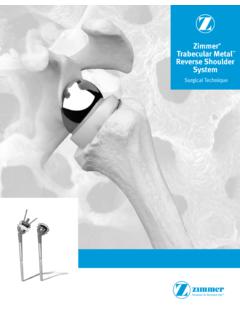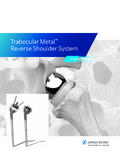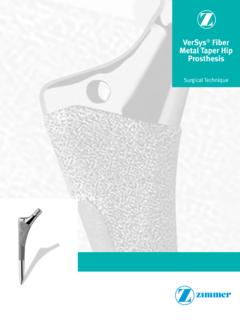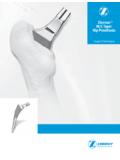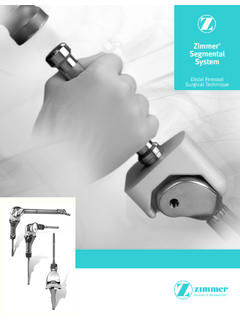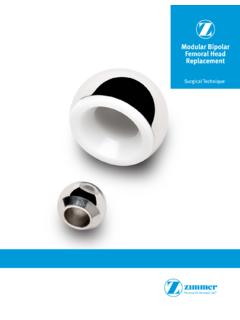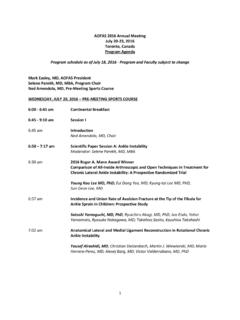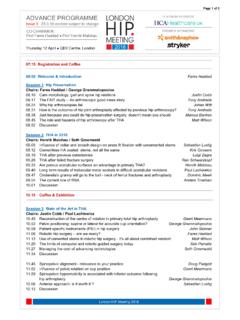Transcription of Zimmer Trabecular Metal Total Ankle
1 Zimmer Trabecular Metal Total Ankle Surgical B8/26/14 2:47 PM8/26/14 2:47 of ContentsIntroduction Trabecular Metal Ankle Surgical Technique SummarySection 1: Preoperative Planning 1 Section 2: Exposure and Sizing 3 Section 3: Alignment and 7 External FixationSection 4: Sizing and Positioning 18 Section 5: Bone Preparation 23 Section 6: Rail Hole Preparation 34 Section 7: Trial Reduction 42 Section 8: Implant Insertion 45 Section 9: Repair and Closure 52 Section 10: Postoperative Protocol 53 Section 11: Poly Revision Procedure 54 Appendix A: Alignment Stand Assembly 58 ZimmerTrabecular Metal Total Ankle Surgical Technique Zimmer Trabecular Metal Total Ankle Surgical C8/26/14 2:48 PM8/26/14 2:48 Trabecular Metal Total Ankle Surgical TechniqueIntroductionThe Zimmer Trabecular Metal Total Ankle is an implant and instrument system engineered to preserve motion in Ankle arthroplasty patients.
2 The semiconstrained device is designed to provide joint mobility by restoring alignment, reducing pain, and preserving the fl exion/extension movement within the Ankle joint. It is indicated for use with bone cement. The system consists of three implant components: a talar component, a tibial base component, and a modular tibial articular surface. The implants are available in six different sizes to accommodate variations in patient anatomies (Fig. 1). Talar ComponentThe convex talar component (Fig. 2), available in separate right and left confi gurations, is made from Zimaloy (CoCrMo) Alloy with a Trabecular Metal distal surface and a thin interlayer of commercially pure titanium. Similar to the natural Ankle , its bicondylar articular geometry has a larger sagittal radius of curvature laterally than medially.
3 The distal surface includes two fi xation rails to facilitate stability. Fig. 1 Fig. D8/26/14 2:48 PM8/26/14 2:48 Trabecular Metal Total Ankle Surgical TechniqueTibial Component The concave tibial component (Fig. 3) is symmetrical, allowing it to be used for both right and left ankles. The tibial base is made from Tivanium (Ti-6Al-4V) Alloy diffusion bonded to a Trabecular Metal surface. The proximal surface includes two fi xation rails to facilitate modular articular surface (Fig. 4) is manufactured from Prolong Highly Crosslinked Polyethylene. Each size is available in three thicknesses (+0mm, +2mm, and +4mm) to facilitate proper ligament balancing. Fig. 3 Fig. E8/26/14 2:48 PM8/26/14 2:48 Trabecular Metal Total Ankle Surgical TechniqueArticular GeometryThe articulating surfaces mimic the truncated cone shape of the Ankle joint and are designed to reproduce natural joint kinematics.
4 The natural talus has a complex geometry characterized by a bicondylar shape where the lateral radius of curvature is greater than the medial. The Talar Component has a bicondylar articulating surface built on an 8 conical axis to replicate this geometry (Fig. 5). The articular geometry of the implants is semiconforming in both the sagittal and coronal planes to allow semiconstrained motion similar to the natural Ankle (plantarfl exion/dorsifl exion, internal/external rotation, and A/P translation). The radii of curvature of the bicondylar articular geometries are designed to allow for full contact of a condyle through varus/valgus angulations (Fig. 6). Fig. 6 Fig. F8/26/14 2:49 PM8/26/14 2:49 Trabecular Metal Total Ankle Surgical TechniqueStability FeaturesThe fi xation surfaces of both the talar and tibial components are cemented into place in the area of the rails to enhance stability.
5 Additional stability is achieved by the curved implant geometry, and through the interference fi t of the two rails, which are oriented perpendicular to the fl exion/extension axis. The orientation of the rails is designed to provide enhanced stability compared to stabilization features oriented in the sagittal plane (Fig. 7). The implant surfaces and bone resections are curved to help reduce the risk of implant subsidence (Fig. 7). This also increases the effective contact area between the prostheses and the bones, allowing joint loads to be more broadly distributed. The design also places the implants in a region of greater bone density. The Trabecular architecture of the proximal talus has a radial orientation. The curved bone/implant interface is designed to be better aligned with this Trabecular architecture to transmit forces to the underlying bone at vectors similar to the natural Ankle .
6 As such, bone remodeling of the microarchitecture in response to changes in load transmission may be minimized. Fig. 7 Prolong Highly Crosslinked PolyethyleneProlong Highly Crosslinked Polyethylene has a heritage of more than 10 years of clinical use as a bearing material in Total knee arthroplasty. Wear, delamination, pitting, and cracking in conventional polyethylene occur from the combined effects of surface stress, subsurface fatigue, and oxidation1. Due to the virtual elimination of free radicals, Prolong Polyethylene is designed to resist oxidation, reduce surface wear, and reduce subsurface G8/26/14 2:50 PM8/26/14 2:50 Trabecular Metal Total Ankle Surgical TechniqueAlignment SystemThe Zimmer Trabecular Metal Total Ankle uses a proprietary set of instruments designed to provide reproducible results (Fig.)
7 8). The system relies on rigid fi xation of the anatomy to help ensure that anatomic alignment is accurately reproduced. The alignment system is intended to produce bone resections that are perpendicular to the mechanical axis of the tibia and parallel to the fl oor. Transfi bular Surgical ApproachThe Zimmer Trabecular Metal Total Ankle employs a lateral transfi bular approach rather than an anterior approach (Fig. 9). This approach requires an osteotomy of the distal fi bula and sectioning of the anterior talofi bular ligament (ATFL), both of which are repaired at the end of the transfi bular approach is intended to maintain the integrity of the blood supply to the skin, potentially reducing the likelihood of wound healing complications. It also facilitates direct visualization of the anatomic center of rotation to aid in properly reproducing the joint axis.
8 Furthermore, it allows for coronal plane deformity to be addressed without substantial release or reconstruction of the deltoid ligament. This is accomplished by lengthening or shortening the fi bula to balance the calcaneal fi bular ligament with the deltoid 8 Fig. H8/26/14 2:50 PM8/26/14 2:50 PMTalar WidthEtch Marks5-10 10 referencePlace Straight Retractor into Medial GutterFig. 26 The patient should be preoperatively assessed for joint alignment and for optimal implant size. The estimated size will later be confi rmed lateral incision and oblique osteotomy of the fi bula, refl ecting the medial gutter through anteriomedial arthrotomy. Determine largest size M/L without 3: Alignment and External FixationCenter and align joint in sagittal talus and tibia in transverse plane.
9 K-WireDistal Fibula SegmentFig. 16 Saphenous Vein and NerveIncisionFig. 17 Fig. 40cAdjustTibial Alignment RodLateral border of the tibiaFig. 35 Tibial Tuberosity VerticalTibial CrestParallelTibial CrestFig. 23 Fig. 12 Fix foot to alignment stand with transcalcaneal pin and talar neck tibia in coronal Until BowedProtective CapFig. 30bFix tibia to Alignment 1: Preoperative PlanningZimmer Trabecular Metal Total Ankle Surgical Technique SummarySection 2: Exposure and Trabecular Metal Total Ankle Surgical TechniqueFig. I8/26/14 2:50 PM8/26/14 2:50 PMSweepClockwiseFig. 64 Fig. 85 Fig. 91 HemostatFig. 42 Fig. 48cSize 3-4 Size 1-2 Size 5-6 Fig. 52 PerpendicularTibial ComponentTalar ComponentImpactFig. 102 Cement Delivery NeedleFig. 106 Fig. 108 Section 4: Sizing and PositioningDetermine fi nal implant size from A/P cutting guide at anatomic center of 5: Bone PreparationPerforate bone for selected implant bone using the provided 6: Rail Hole PreparationDrill rail holes for the 7: Trial Reduction Perform trial reduction and range of 8: Implant InsertionInsert fi nal cement under implant rails using cement delivery syringe and nozzle.
10 Note: This device is intended for cemented use only. Section 9: Repair and closureRepair the fi bula and close all wounds. Trabecular Metal Total Ankle Surgical J8/26/14 2:50 PM8/26/14 2:50 PM1 SECTION1 Section 1: Preoperative PlanningSection 1: Preoperative PlanningIndicationsTotal Ankle arthroplasty is intended to provide a patient with limited mobility by restoring alignment, reducing pain and preserving the fl exion/extension movement within the Ankle joint. The Zimmer Trabecular Metal Total Ankle is indicated as a Total Ankle replacement in primary or revision surgery for patients with: Rheumatoid arthritis. Post-traumatic arthritis. Degenerative device is intended for cemented use only. Contraindications Local/Systemic infection that may affect the prosthetic joint.
